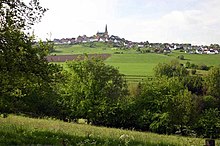Kallenhardt
|
Kallenhardt
City of Rüthen
|
|
|---|---|
| Coordinates: 51 ° 27 ′ 6 ″ N , 8 ° 25 ′ 26 ″ E | |
| Height : | 410 m |
| Residents : | 1665 (Dec. 31, 2014) |
| Incorporation : | 1st January 1975 |
| Postal code : | 59602 |
| Area code : | 02902 |
|
View of Kallenhardt
|
|
Kallenhardt is a district of Rüthen in the Soest district ( North Rhine-Westphalia ). On December 31, 2014 the village had 1665 inhabitants.
Geographical location
Kallenhardt is located in the Sauerland , south of the city of Rüthen in the Arnsberg Forest at 284–528.9 m above sea level .
history
In the immediate vicinity of the place is the Iron Age fortification on the sheep's heads . A predecessor settlement with a church was mentioned in 1072 in the deed of foundation of the Grafschaft monastery as the main courtyard of the Electorate of Cologne. The city was founded as planned before 1297 on a hilltop to protect against Arnsberg by the Archbishop of Cologne. The place with the church of St. Clemens and a town hall was fortified by a city wall and three gate towers. Since the Middle Ages , Kallenhardt belonged to the Electoral Cologne Duchy of Westphalia and in 1802 came to the Landgraviate of Hessen-Darmstadt . From 1808 the city wall was torn down. In 1811 the Kallenhardt district was founded. This came in 1815 to the Kingdom of Prussia and the Brilon district . In 1820 the place moved to the Lippstadt district . On January 1, 1975, Kallenhardt was incorporated into the city of Rüthen by the Münster / Hamm Act . and has been part of the Soest district since then .
From 1573 to 1619, numerous residents were victims of witch trials . In total, the number may exceed 40 people. On March 31, 2011, the city council of Rüthen decided on a socio-ethical rehabilitation of those innocently convicted and executed in the area of today's city of Rüthen during the 16th and 17th centuries as part of the witch persecution.
Population development
- 1861: 1038 inhabitants
- 1939: 997 inhabitants
- 1950: 1376 inhabitants
- 1961: 1362 inhabitants
- 1970: 1541 inhabitants
- 1974: 1506 inhabitants
- 1975: 1482 inhabitants
- 2007: 1950 inhabitants
- 2008: 1975 inhabitants
- 2011: 1690 inhabitants
- 2013: 1656 inhabitants
- 2014: 1665 inhabitants
politics
The mayor is Bernd Postler (SPD).
Culture and sights
Buildings
The Körtlinghausen Castle is a special feature . The baroque moated castle was built in 1714. The Catholic Church of St. Clemens is also worth seeing . It was built in the baroque style in 1722. The former town hall dates from the Middle Ages (14th / 15th century). There is also a charcoal burner hut and the “ Hohler Stein ” culture cave to visit. Numerous residential and farm buildings from the 17th and 18th centuries have been preserved despite a number of fires, especially in 1791. The city wall from around 1300 was redesigned after the city fires in 1791 and 1836. The semicircular Lubleisturm was reconstructed on the northeastern Unteren Straße . The listed old town hall , Kirchstrasse 31, is worth seeing .
freetime and sports
At the Rabennest there are toboggan slopes and a ski slope with a drag lift. Cross-country trails lead to the Nuttlarer Höhe (approx. 540 m above sea level ). There is also a bike park .
The football club TV 1897 Kallenhardt is at home in the village.
Kallenhardt is characterized by a lively club life. In 1829 the wind and dance orchestra and in 1921 the drum corps "Unity" were founded. Both clubs enrich village life through their youth work and musical performances.
Infrastructure
Kallenhardt has a butcher's shop, a bakery and a hotel with an inn.
traffic
A Westfalenbus GmbH bus line , the R77 line from Warstein to Rüthen, runs through Kallenhardt. The buses run every hour on weekdays in both directions.
education
- Catholic kindergarten
- Primary school (Catholic sub-location of the Nikolaus Primary School Rüthen)
Personalities
- Gorgen Bodeker , a tailor, got into a witch trial in 1576 , his mother in 1586.
- Cort Synneman was mayor of Kallenhardt. He was mentioned in a document in 1521, he acted as surety for Heinrich Steyn, who was sentenced to death and then pardoned. The trial took place before the jury in Brilon. Hermann von Oeynhausen was a judge at Brilon.
Web links
- Official website of Kallenhardt
- Document registers from the Rüthen city archive with holdings from Kallenhardt / digital Westphalian document database (DWUD)
Individual evidence
- ↑ Stadt & Tourismus> Ortsteile , accessed on May 17, 2016
- ↑ a b Ursula Quednau (edit.): Dehio-Handbuch der Deutschen Kunstdenkmäler, North Rhine-Westphalia, Volume II: Westphalia. Deutscher Kunstverlag , Berlin / Munich 2011, ISBN 978-3-422-03114-2 , p. 944.
- ^ Federal Statistical Office (ed.): Historical municipality directory for the Federal Republic of Germany. Name, border and key number changes in municipalities, counties and administrative districts from May 27, 1970 to December 31, 1982 . W. Kohlhammer, Stuttgart / Mainz 1983, ISBN 3-17-003263-1 , p. 335 .
- ^ Alfred Bruns: Inventory of the Brilon City Archives, A. ed. from the State Office for Archive Maintenance, Verlag Aschendorff, Münster 1970, p. 23.





